Professional Foundations of Learning Design Technology
All artifacts are accessible through download at the bottom of each reflection. Note that it may ask you to rename the file upon download.
Challenge #1: Comply with organizational and professional codes of ethics
Artifact: Plagarism Certificate
Reflection:
As part of the Master of Science in Education in Learning and Technology program at Purdue University, I was required to complete a plagiarism course. The course discussed the importance of avoiding plagiarizing as students, recognizing plagiarism and shared best practices on how to detect plagiarism through a series of tutorials. To proceed in the course, it was imperative that I passed and received the plagiarism certificate, which I am glad that I did. As part of challenge one I am going to share my artifact which is my plagiarism certificate. Following a Code of Ethics is important not only as an Instructional Designer but in any role and in any profession. A Code of Ethics is a guiding document that brings awareness and helps professionals understand how to behave or conduct themselves under a specific set of and generally non-negotiable rules or guidelines. A Code of Ethics may differ by type of industry, field, or job. As a working professional with over five plus years of experience, I have read and obliged to many “Code of Conduct” policies in the organizations where I have worked. A “Code of Conduct” or Code of Ethics is widely enforced by many organizations to ensure good behavior and conduct in the workplace.
How Following a Code of Ethics Affects my Decision-Making Process in Instructional Design/Other Aspects of my Work
There are several ways in which following a Code of Ethics affects my decision-making processes in instructional design:
Designing with the user experience in mind: By adhering to a Code of Ethics, I must design content that fosters a positive and seamless user experience. This means both respecting and understanding that all learners learn differently and may require certain experiences to make learning more accessible to them. Developing accessible, inclusive, and engaging learning experiences are some ways in which I can develop content that will equally benefit all learners.
Respect for diversity and perspectives: By adhering to a Code of Ethics, I must design content that applies to all learners. The audience is very crucial – can they relate or understand the content? Knowing the language preferences, gender or other biases to ensure that the learning is inclusive. Some ways to do this is by including scenarios that are reflective of all gender types, offering content that is available in various languages, including closed captioning and so forth.
Collaboration and communication: A Code of Ethics encourages collaborative relationships as well as clear and friendly communication. Collaboration and communication both result to better outcomes and overall strong working relationships.
Continuous improvement: As an Instructional Designer I must constantly update and refine my work to keep it relevant. Regularly seeking feedback from my stakeholders to adjust the content to continue meeting learner needs and to improve the overall effectiveness is key.
The artifact I am sharing with you is my plagiarism certificate from course EDCI 60001: Introduction to Demonstrating Professional Competencies in LDT.
This artifact was achieved because I demonstrated that I understood and will apply what I have learned in the course to my work not only in this master’s program but also as a learning professional in the workplace. In my current role as a Learning and Development Specialist but also the only Instructional Designer on the team, I am responsible for supporting business stakeholders by developing instructional materials such as job aids, elearning courses, videos etc., which may require conducting external research. As an Instructional Designer it is my responsibility to ensure that the work I produce is free of plagiarism and is reflective of my own knowledge and experiences. In the events where I am required to do research and seek out external resources, they must be properly cited.
Challenge #2: Aquire and apply new technology skills in instructional design practice
Artifact: This site is the artifact - website Development, LDT Portfolio
Reflection:
As part of the Master of Science in Education in Learning and Technology program acquired a new skill: Website Development / Web Design. In this reflection, I will share my process of developing a website, my experience developing a website for the first time, what skills I acquired, am continuing to build or can improve through this experience, and how I have or will apply (and will continue as I enhance my website) my existing ID knowledge in my website development.
Website Development Process
To develop my website, the first thing I did was storyboard or build a high-level “strawman” of how I envisioned my website. To storyboard my website plan, I used my Remarkable 2 notebook to sketch a few rough images of my website homepage and the remaining pages/tabs. The sketches identify what my vision is for each page using the various blocks available on the website tool. When I was ready to develop a first draft of my site, I used this outline to develop my website on Site123, which is a free site development tool. See my rough work below:
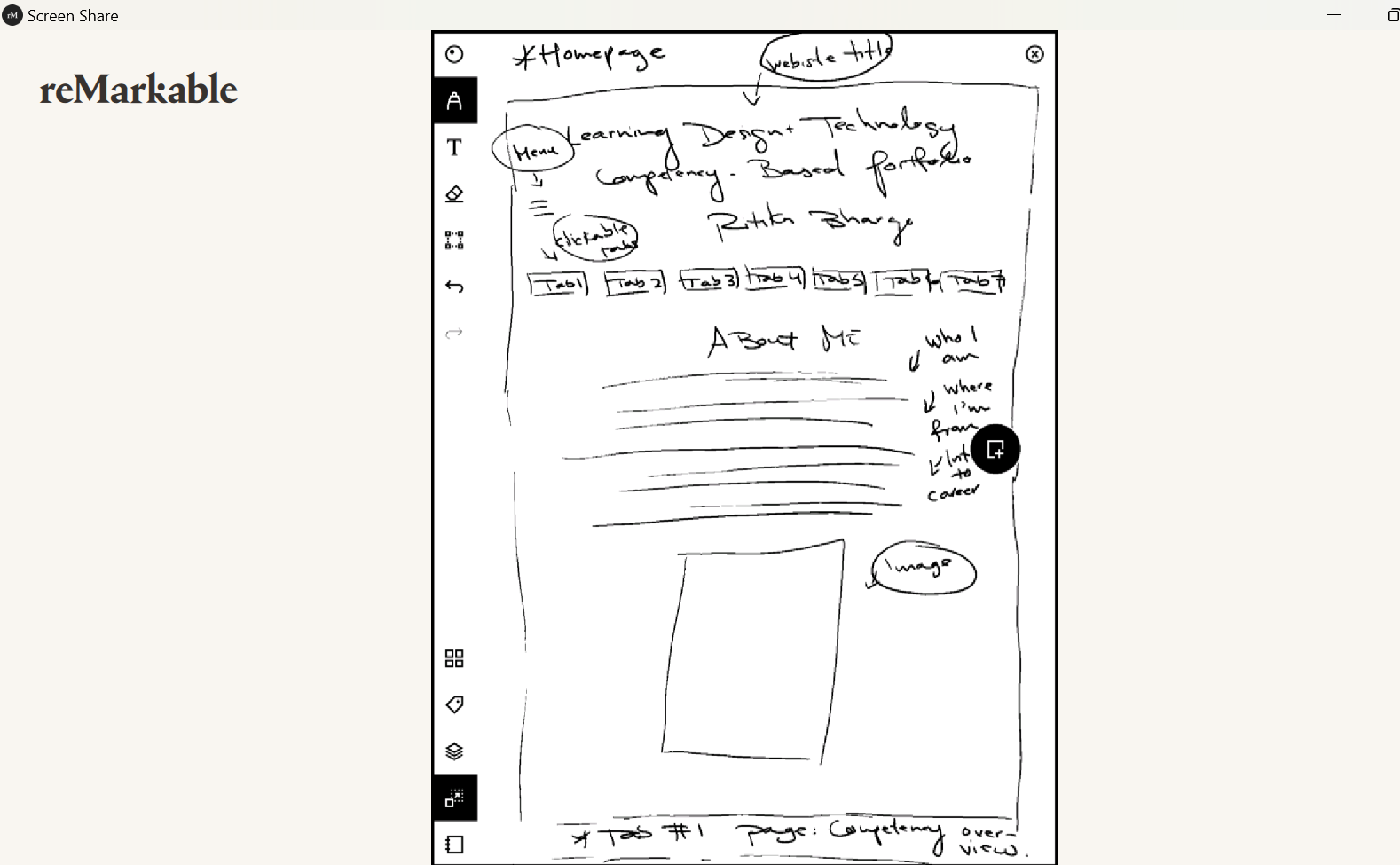
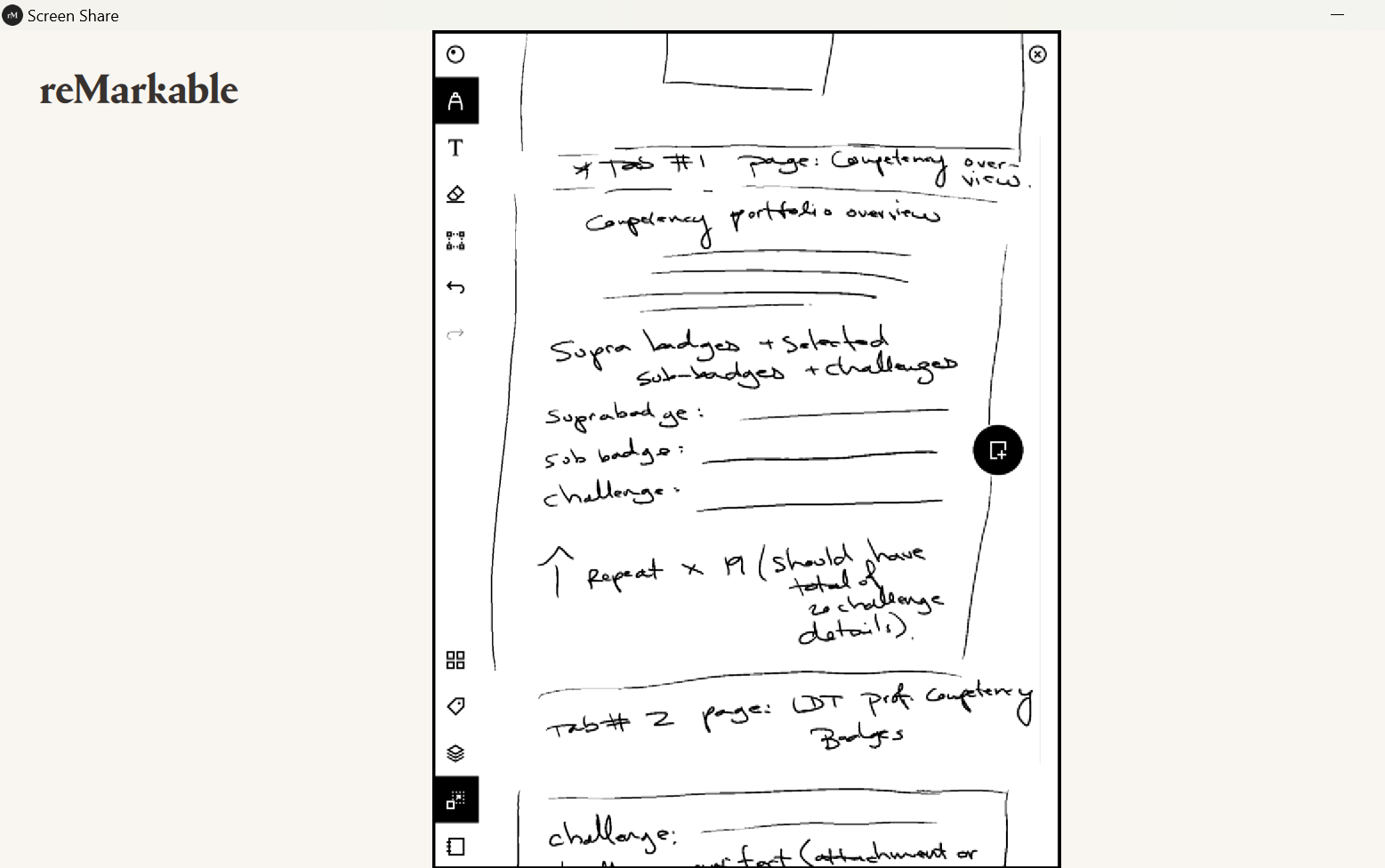
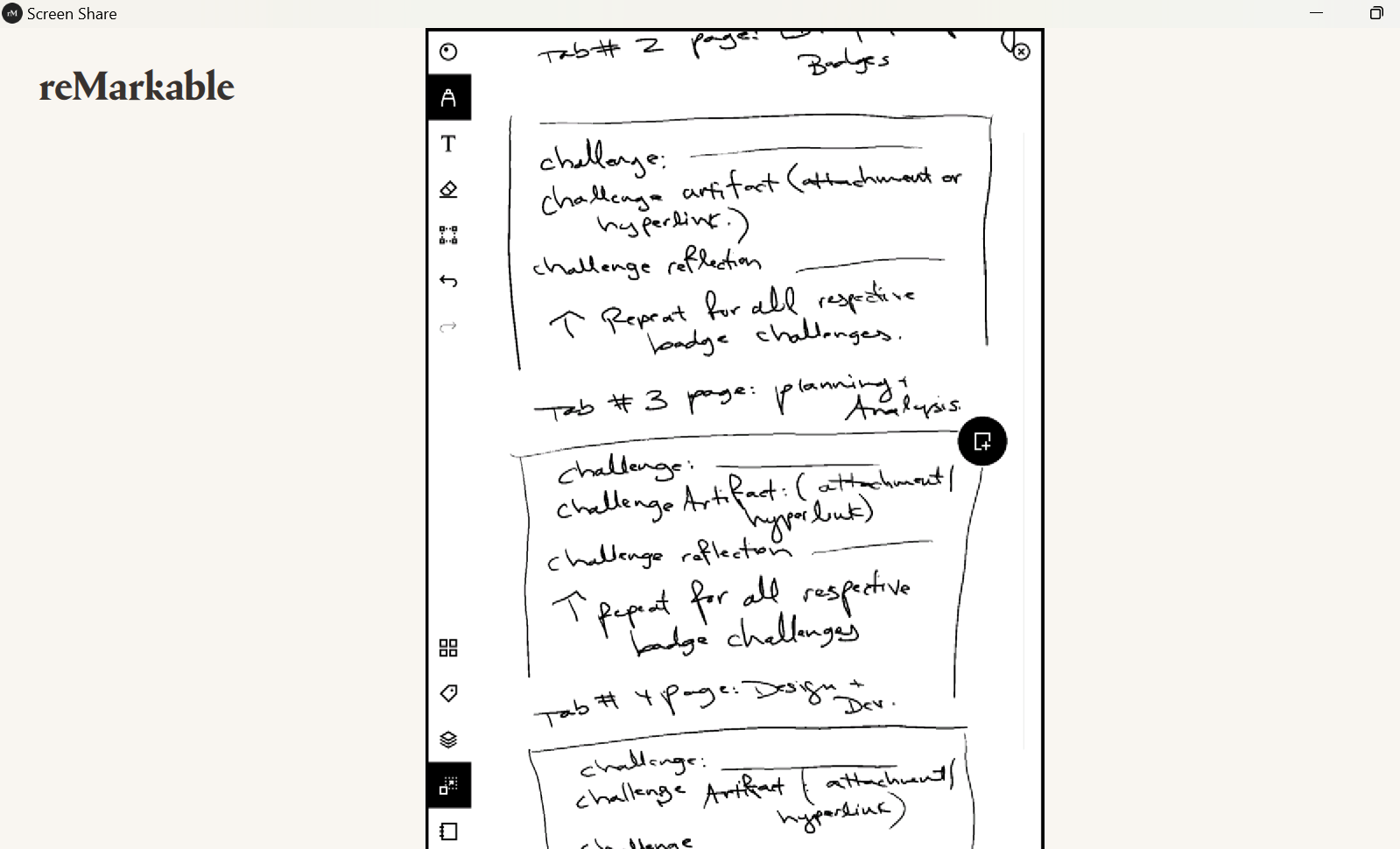
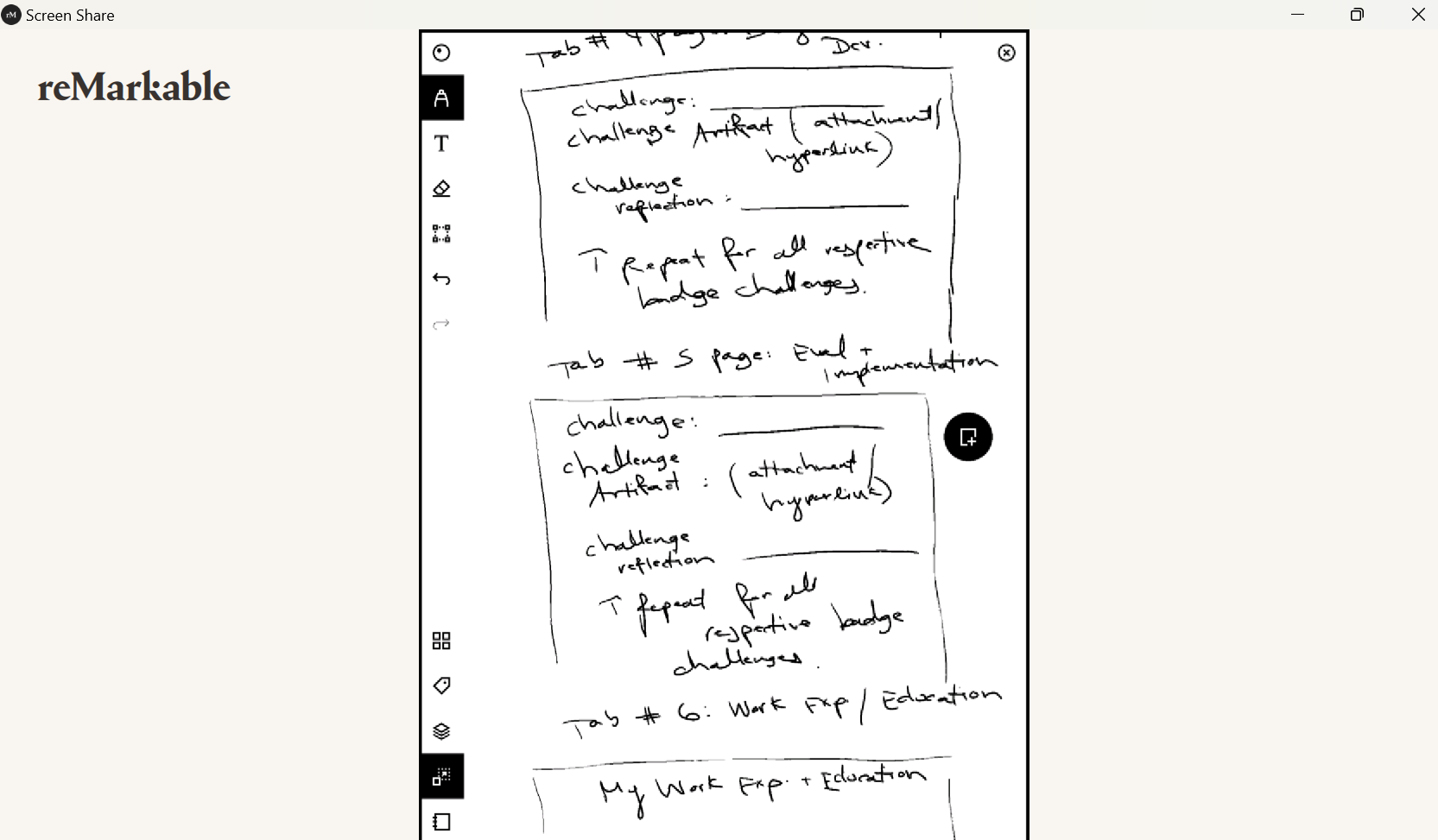
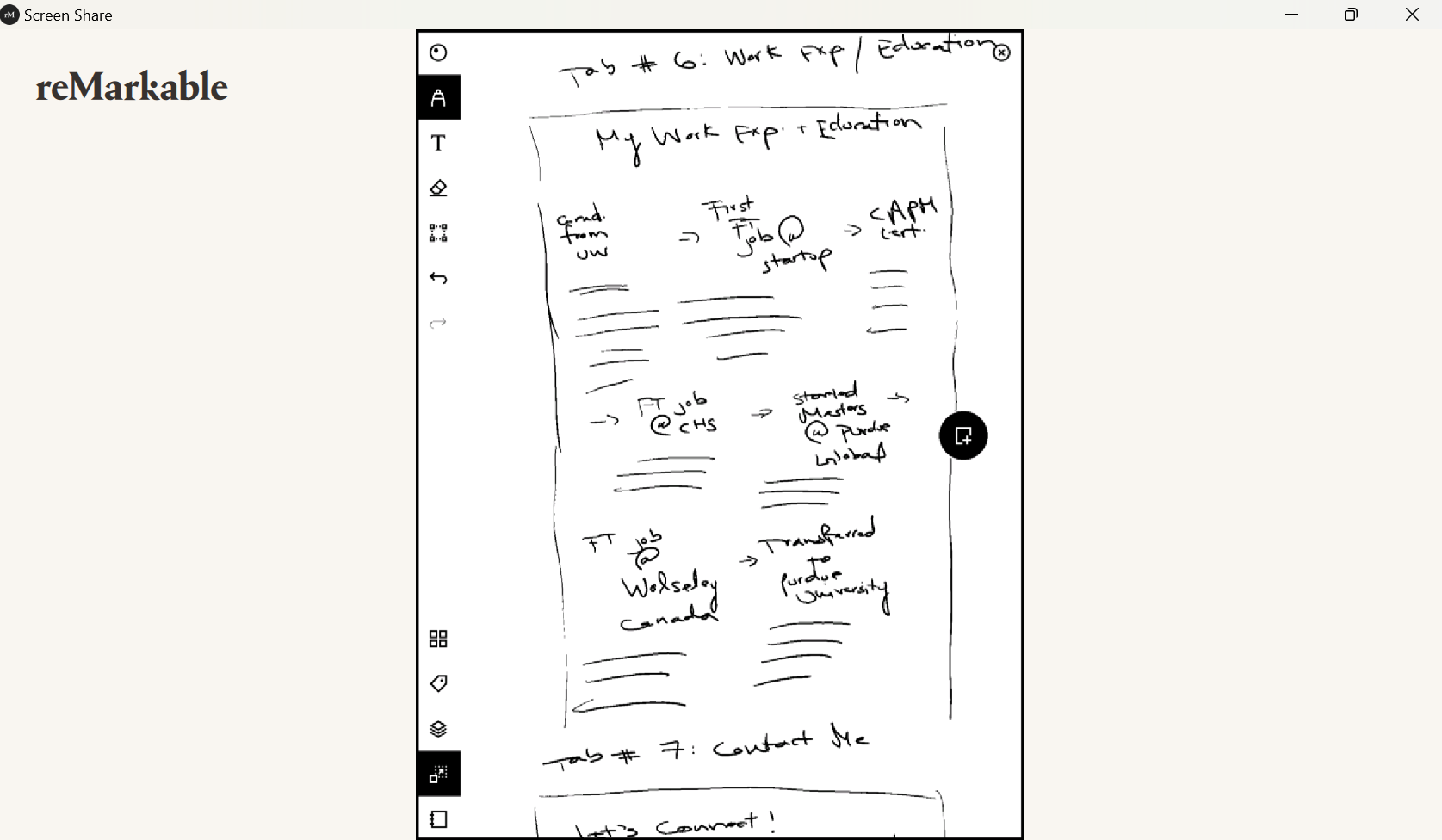
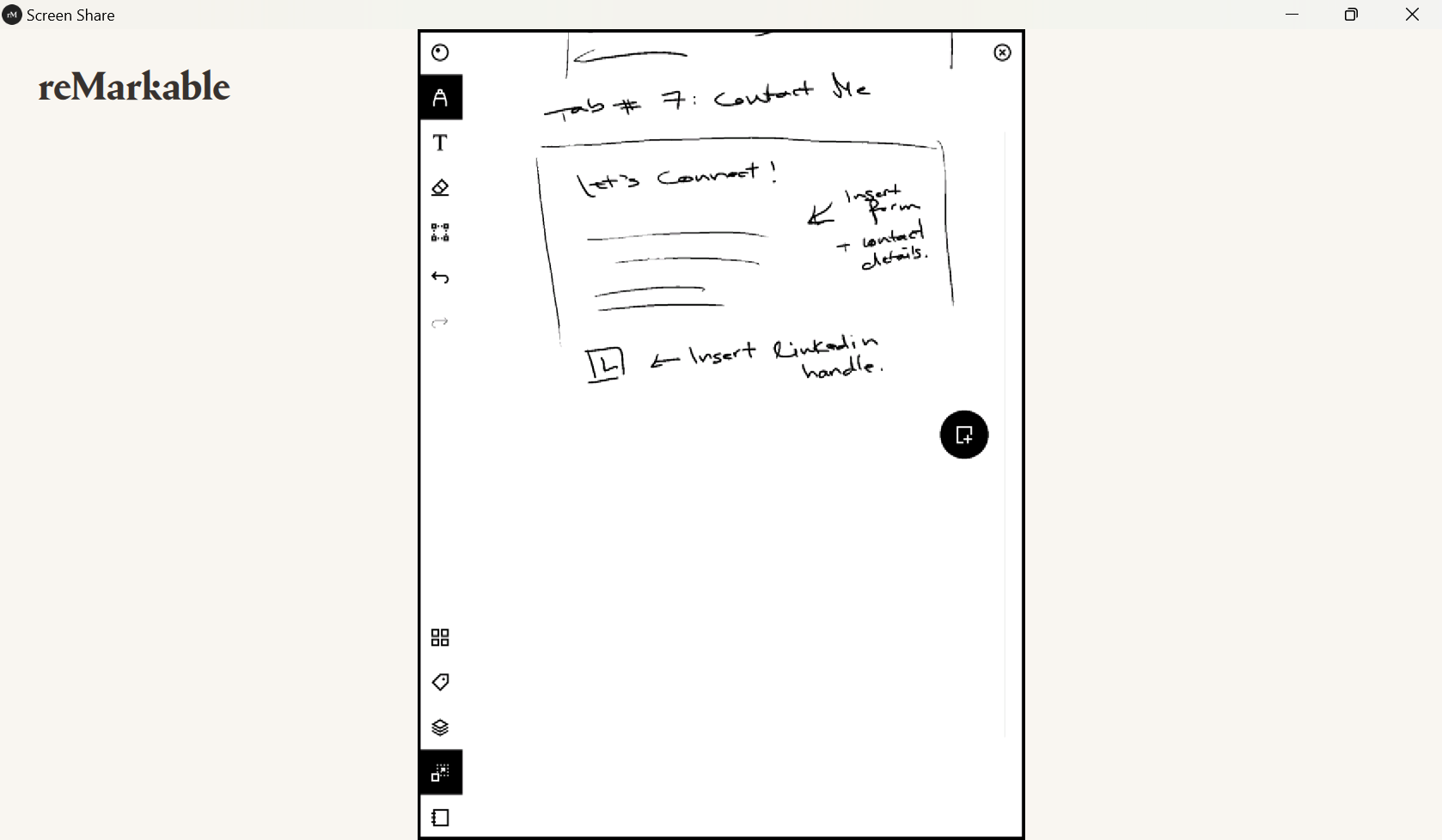
My Experience Developing a Website
As a Learning professional who has been in the industry for over five years now, I have thought of developing a website to display my work or portfolio. However, I never got the opportunity to do so. When I found out that it’s the LDT program requirement to develop a portfolio, I was thrilled! Though I am in the early stages of building out my website, I would say that it has been a good learning experience so far. I am using Site123 to develop my website and it has been quite seamless to use the different blocks (text, about, contact, timeline etc.) and overall to use the website as well as adjust/move items around. While I have experience in HTML (self-taught through my experience with developing Zendesk articles for a previous job), coding skills were not required to develop this website.
Skills Acquired and Applying My ID Skills
The idea of building a website on itself is a new skill that I have gained through this challenge. However, I have existing experience with design and development as I have developed and designed SharePoint pages, Zendesk articles, eLearning courses, job aids, guides, and infographics for professional and job-related work. There are several design considerations that I put into use while developing this website such as:
User experience: Anyone that visits my website should have a seamless and easy user experience. I have designed my website such that it’s easy to navigate and not cumbersome or overwhelming. Sometimes, simplicity is key!
Color theory/backgrounds: The website should be accessible to all. One thing I have done to ensure that is if you look at my homepage, it’s white color font over a darker colored background so that it’s easily legible. It’s not an accessible experience if the font color is light and so is the background. However, I see opportunity to increase the overall text font size so it’s a little more legible as well as use better and more images to display my thoughts.
Creativity: I display creativity using various available block components. My website includes several elements such as an about section, text blocks, timeline, contact, multimedia (images and video), and I have inserted a couple of links as resources for people to download.
Clear and concise communication: Effectively articulating my work experience and my progress in the LDT program is necessary for peers, instructors, and employers that may view my website. It is imperative I write clear, well articulated, and concise messages as I continue to build my portfolio. Additionally, I want my portfolio to reflect my personality so this is an area I can continue to reinforce and work on. I should consider “What do I want others to know about me and how can my website best reflect that?” For example, while it is not a requirement to add my personal “core values” I think it adds value and context to who I am and my work.
In summary, these are some skills that are applicable and important to remember as an Instructional Designer in the workplace as well. Creating unique learning experiences that are accessible and easy to navigate is critical for developing engaging and effective learning experiences and journeys. I am looking forward to continuing to build my website and sharpen my ID skills in the process!
Challenge #3: Solicit, accept, and provide constructive feedback
Artifact: EDCI 531 Final Project: Job Aid, Peer Feedback
Reflection:
In this challenge I demonstrated requesting and providing constructive feedback to a peer. In this reflection, I will share my process of requesting feedback, utilizing the feedback received, and reciprocating or providing constructive feedback to a peer.
Requesting Feedback
For the EDCI 531: Job Aid final project, I was required to write a 4–5-page paper and develop a supplementary job aid. I wanted feedback from a peer in my class on my paper to ensure I was on the right track and didn’t miss any rubric requirements. The following is an overview of my process when requesting, utilizing, and providing feedback:
Identify who to ask for feedback: Over the course of the class, I developed a great relationship with one of my peers. For another final project called “Designing with the Theories” in the class, we were divided into “peer feedback groups” where we’d reflect on that week’s theory and apply it to our topic of choice. Then at the end of the week we’d get feedback from our peers and we’d participant in some back-and-forth conversations. There was three of us in that group. During the period of peer feedback groups, I developed a good relationship with one of my peers. For this project, I requested her for feedback. When identifying who to ask for feedback, it’s important you pick someone who is genuinely interested in giving good feedback as opposed to someone who is biased towards you or your work. This person offered great constructive feedback, which overall helped me improve my work.
Request for feedback: Once the individual is identified, it is important to request for the feedback. I requested feedback over an Instant Message in Brightspace first before I sent over my assignment for feedback. By doing this, I was able to gauge my peer’s interest and availability in being able to provide me with feedback.
Schedule a call: This can be done prior to or after the official feedback has been received and provided. A call can be useful to discuss the feedback in detail or provide additional context for why a certain comment was made as not everything can be explained in the way one intends or interpreted by others over written messages. In my scenario, this step is multipurpose as we used the call to both communicate and provide/clarify our feedback to one another.
Provide constructive feedback: My peer kindly requested feedback as well, so I made sure I provided her with constructive feedback. In our call, I went over my comments, and she was very receptive of the feedback and informed me they were things she didn’t even think about and will greatly help her improve her project. To provide constructive feedback, I went over her paper and reviewed her job aid in detail. Then I left comments directly on her paper of things I suggest she can do to enhance her overall project. Additionally, for grammar related feedback, I made direct track changes in her document. Once I completed providing my feedback, I sent her an email with my revisions and then we had our call.
Go though the feedback/apply as needed: I went through each of the comments provided and applied them to enhance my paper. My peer left several comments on my paper. Once I read through each of the comments, I selected the ones I could implement. It is not necessary to accept every piece of feedback as the intention is to provide constructive suggestions. To notify my peer I left replies with my actions/next steps, so they knew what feedback I accepted or rejected and why.
Prior Knowledge and Reflection on Experience: Requesting Feedback
I have had various opportunities in both my academic and professional careers to solicit feedback from peers has been valuable in refining my work. Having peers review my work who have fresh perspectives has helped me in identifying blind spots that I may have missed. As a designer it is very o easy to get sucked into what you're developing because you've looked at it so many times. For example, in my current role as an Instructional Designer, I get my subject matter experts (SMEs) to review the instructional products I develop for them in two rounds of review - alpha review and beta review. The key is to ask with intention, which also sets an expectation for the SME on what to review and how. The alpha review is an opportunity for my SMEs to provide feedback on the content, the design, overall structure and flow of the content as well as grammer and puncuation. During beta review, the SMEs are asked to focus on the overall flow and structure of the content as well as share anything they may have missed during the alpha review. These review structures have helped me refine the outputs I deliever, greatly.
Challenge #4: Write and edit messages that are clear, concise, and grammatically correct
Artifact: EDCI 531 Job Aid
Reflection:
In this challenge I demonstrate writing a job aid as part of my EDCI 531 final project called Designing with the Theories to convey ideas in a consumable format that were shared in my paper. In this reflection I will describe the format and techniques I used to develop my job aid and general principles I take into consideration when developing job aids in the context of a workplace as well. I have also attached another sample job aid template that I like to use in a workplace context. Based on my general knowledge of developing job aids and what I seen in the workplace, job aids are two-three-page documents that act as resources and are developed to help a learner complete on-the-job task, learn how to access a certain platform or tool, or to educate learners on a given topic. Like quick reference guide, it acts as a “cheat sheet” to help the learner gain information on a topic or to do their job better. It is important to keep job aids brief so that it is easy for the reader to digest the information and use it as a reference document in the future. Job Aid Design Since my job aid is not an on-the-job resource, I did not include any specific images or step by step instructions. Rather, my job aid design is simple, and I use clear titles and headings so that the readers can navigate with ease. I had to summarize the different learning theories I discussed in my paper (this was the task) into a job aid style document.
Job Aid Tools
I have developed job aids in various tools such as MS Word, PowerPoint, Adobe, and Canva Pro. For this assignment I used Canva, which is a graphic design tool. I prefer Canva over a lot of other tools because of its simplicity and ease of navigation and use. It’s a very intuitive graphic design tool.
Techniques/formats I used to write a QRG
Headings and sub-headings: I use headings to help inform the reader of the topic. I use capitalization of words and highlighted my headings in blue, so they are easy to distinguish from the rest of the job aid. Additionally, each heading has a corresponding number assigned so it’s easy to follow as there are six theories that I explore.
Chunking information: Job aids should be easy to read and glance as needed so I use bullet points and brief sentences instead of writing large paragraphs.
Bold, italicize, color words to help them stand out: I choose to bold the subheadings so they’re easier to distinguish from the actual content of the job aid. In addition, I bolded certain key words that I wanted to emphasize and use the color to red so it’s easier to identify.
Write short and concise messages: I have used a combination of full but brief sentences or bullet points to convey my messages.
Overall, job aids can be helpful resources for sharing bite-sized information with learners or for on-the-job training.
Challenge 5: Apply systems thinking to instructional design and performance improvement projects
Artifact: EDCI 672 Paul Lindley Case Study Analysis
Reflection:
In this reflection I will share and discuss how my artifact shows the breakdown of the design process into individualized pieces. My artifact is a case study assignment from the EDCI 672: Advanced Practices in Learning Systems Design class. I will discuss how I began the process of using a systems thinking approach to arrive at a recommendation or solution to the case study that I evaluated.
What is the Paul Lindley Case?
The Paul Lindley case is a case study in The ID CaseBook: Case studies in instructional design (5th ed.)., edited by Peggy A. Ertmer, James A. Quinn, and Krista D. Glazewski. The case itself is focused on designing an educational video game for history education on the topic of the role of sport, specifically Baseball, for the Japanese Americans during World War 2. In EDCI 672, students completed a total of three case studies to carefully analyze the case to understand the design issue at hand before offering any instructional design related recommendations. Sometimes the solution isn’t the answer to solving the design or instructional issue at hand. This competency focused on teaching us how to evaluate all the parts of the scenario (in this case, the case study) prior to providing any final recommendations or solutions.
Applying Systems Thinking
My case analysis applies a systems thinking approach by understanding how different parts of the case study interact with one another within a larger case rather than treating issues in isolation. This allowed me to analyse a series of questions prior to jumping to final conclusions or recommendations. By reviewing each question before making a final recommendation, I analyzed the problem holistically. Even in the context of a workplace, systems thinking is essential for tackling challenges in a holistic and organized way.
Many of the key questions I used in my case study analysis placed greater emphasis on the analysis phase of the ADDIE model as they helped identify where the core design issue or gap is. All the case study questions helped me better understand the role of each stakeholder and how their expertise or goals may influence the design and delivery of the learning content. Ultimately, this helps in defining the scope of the project, the learning objectives, and the constraints that need to be considered during the design and development phases.
Below is the list of questions I explored in my case study:
“Who are the key stakeholders in the case and what are their primary interests and/or concern?”
“Describe important details regarding each stakeholder regarding the context of the project.”
“What are the key instructional design challenges in the case?”
“What has the designer been tasked to do?”
“Where in the ID process does the main design challenge fall?”
“How might other case-specific challenges impact the ability of the designer to address the design challenges?”
“Think of the constraints in the case that make it hard for the designer to complete his/her ID tasks.”
“How would you prioritize the design challenges and case-specific challenges you identified and explain why you would choose this order?”
“Provide a concise reflection on how previous experiences have attributed to your understanding of the case.”
“Many potential solutions exist for a given ill-structured problem. Outline two different but reasonable solutions/recommendations for the designer in the case.”
“How do these solutions/recommendations address the challenges described in question #2?”
“What is your final recommendation?”